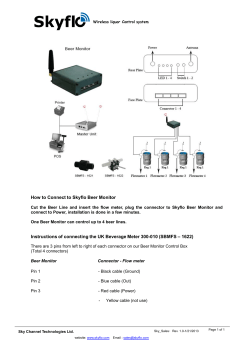
Blending Talents - MediaTracking.com
wa r d r o b e st y l i n g b y p o l ly s pa d av e c c h i a ; g r o o m i n g b y k i m r e y e s data breaches road to wealth ask the expert love and money college second act Plan My first venture wasn’t a failure. It was an amazing education.” Blending Talents after his first beer business didn’t work out, kenny thacker realized the value of drafting partners with complementary skills. by Kerry Hannon kenny thacker, 43, Stanardsville, va. Then construction worker now co-owner of a brewpub Photograph by m e li s s a g o ld e n until 2008, kenny thacker had spent his career working in construction around the tiny town of Stanardsville, Va. But when the homebuilding business came crashing down that year, he found himself without a job. After two frustrating years looking for a new one, he decided to build something other than homes—his own beer-making business. The idea had been brewing in the ale aficionado’s mind for a while, thanks to a favorite sitcom. “Ever since I watched The Drew Cary Show and they were making Buzz Beer, I thought, ‘I could do that,’ ” he says. april 2015 m o n e y. c o m 39 Plan data breaches road to wealth ask the expert love and money dining franchise group, suggested they team up with his pal, Rick Cash, 56, who’d retired from management at Phillip Morris and was looking for a new venture. Together they could reopen Beer Hound in another locale. Cash had capital; Becker had sales/ operations expertise; Thacker could be master perfect blend Thacker (center) is chief brewer at Beer brewer. He leapt. Hound; Becker (left) and Cash handle the business end. After spending a year honing a business plan, the trio leased space in historic Culpeper, a So, in 2010, Thacker and his wife, growing tourist town. The new Leslie, tapped $45,000 of home Beer Hound Brewery opened last equity to buy a local supply shop for fall, with 12 of Thacker’s beers on home-brewing hobbyists. Immeditap. The kegs were empty in 36 ately, he began experimenting with hours. Revenues are now on pace recipes. By 2012, he’d grown confito top $500,000 in 2015. dent in his brewing, and, with a While closing his first businesses $25,000 loan from his dad, opened was tough, Thacker says “the venthe Beer Hound Brewery next door. ture was an amazing education.” Despite a small following, though, The lesson? Sometimes three heads Thacker found it tough to turn a are better than one: “I realized there profit due to the rural location. was no way I could brew the best Then one of Thacker’s customers beer, market it, pay the bills, and had an idea to save the brewery. plan future stuff all by myself.” Frank Becker, 33, a G.M. of a casual 30% by the numbers 5 years $100,000 time before he took a full salary. The thrifty Thackers and their kids, now 12 and 15, mostly made do off savings and Leslie’s $60,000 pay from working as a clerk for a school district and editing a medical journal. With the new location and influx of capital, he now earns $50,000. what it took to launch version 2.0. The initial cash came from Cash, but he, Becker and Thacker agreed to share ownership. Thacker and his wife, together hold the majority of the shares (45%) although he didn’t put any of his own money on the line in this iteration. 40 m o n e y. c o m april 2015 estimated annual sales growth. The trio expects revenues to jump to $780,000 next year and $1.2 million in 2017. But the business plan does not call for a profit until 2018 as the group will be spending to expand brewing capacity and hopes to sign with a local distributor to service area restaurants and grocery stores. Illustration by m i g u e l m o n ta n e r college second act startup how to tell if there’s a market Think you’ve got a million-dollar idea? “Avoid the ‘build it and they will come’ fantasy,” says Dave Mawhinney, co-director of the Center of Innovation and Entrepreneurship at Carnegie Mellon. First figure out if people will pay for what you want to sell. start with research. Gather existing market data compiled by industry associations, government agencies, and trade groups to assess whether there’s a reasonable universe of clients. meet consumers. Get feedback on your idea through sites like AYTM.com, UsabilityHub.com, and UserTesting.com (plans start around $50). Better yet, organize a focus group of target clients, says George Cook, a marketing prof at University of Rochester. You might start with people who’ve commented on your competitors’ Facebook pages. size up the competition. Talk to industry vets and influencers (see who’s quoted in trade pubs) for insight on strengths and weaknesses of competitors. And use the tool at sba.gov/sizeup. Says Mawhinney: “You need to validate that your business solution is way better or way cheaper than others out there.” —daniel bortz
© Copyright 2025









